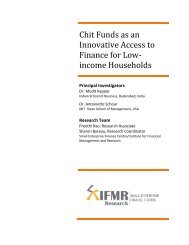Government of India Volume I: Analysis and Recommendations
Government of India Volume I: Analysis and Recommendations
Government of India Volume I: Analysis and Recommendations
You also want an ePaper? Increase the reach of your titles
YUMPU automatically turns print PDFs into web optimized ePapers that Google loves.
CHAPTER 8<br />
Capital controls<br />
Capital controls are restrictions on the movement <strong>of</strong> capital across borders. The design<br />
<strong>of</strong> controls vary from country to country. Typically, capital controls include a range <strong>of</strong><br />
measures from reserve requirements to quantitative limits, licensing requirements <strong>and</strong><br />
outright bans. Controls may be imposed economy-wide or may apply only to specific<br />
sectors. In addition, restrictions may apply to all kinds <strong>of</strong> flows or may differentiate by<br />
type or duration <strong>of</strong> flows.<br />
<strong>India</strong>’s current account is fully liberalised. The Commission has no view on either<br />
the timing or the sequencing <strong>of</strong> capital account liberalisation. These are decisions which<br />
should be made by policy makers in the future. The focus <strong>of</strong> the Commission has been on<br />
establishing a sound framework <strong>of</strong> law <strong>and</strong> public administration through which capital<br />
controls will work.<br />
8.1. Objectives <strong>of</strong> capital controls<br />
While some nations have used capital controls as part <strong>of</strong> their policy response to sudden<br />
inflows, the International Monetary Fund (IMF) recommends that capital controls be<br />
implemented only on a temporary basis, when other macroeconomic policy responses<br />
have been exhausted. The Commission notes that empirical studies present mixed evidence<br />
on the effectiveness <strong>of</strong> capital controls in addressing macroeconomic imbalances<br />
<strong>and</strong> systemic risk. The Commission also acknowledges that, in the current <strong>India</strong>n context,<br />
a distinction must be made between strategic <strong>and</strong> tactical capital controls. While<br />
the former involves defining a ‘credible framework <strong>of</strong> rules <strong>of</strong> the game which can be<br />
used by foreign investors to decide their investment strategy’, the latter would be ‘situation<br />
specific - to be imposed when particular circumstances arise <strong>and</strong> withdrawn when<br />
they abate.’ Consequently, the Commission recommends that capital controls be available<br />
for policy purposes as a temporary measure during macroeconomic crises.<br />
Even in countries which have achieved full capital account convertibility, the legal<br />
framework provides for the imposition <strong>of</strong> controls for preventing foreign ownership <strong>of</strong><br />
certain national assets for reasons <strong>of</strong> national security. The Commission recommends<br />
that in the <strong>India</strong>n context too, the law should restrict foreign ownership <strong>of</strong> national assets.<br />
Accordingly, the draft Code provides for the pursuit <strong>of</strong> this objective with clarity on<br />
instruments <strong>and</strong> objectives.<br />
The application <strong>of</strong> capital controls should be consistent with the principle <strong>of</strong> competitive<br />
neutrality. Controls should only be imposed at the entry level. Once all entry level<br />
FINANCIAL SECTOR LEGISLATIVE REFORMS COMMISSION 81



